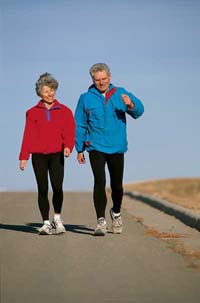
Did you know falls are a leading cause of injury and loss of independence among older adults? Physical changes, your health condition and even the medications you’re taking can make falls more likely. But there are things you can do to help prevent falls—here are seven fall prevention strategies from the National Institute of Health to keep you solidly on your feet.
1. Make an appointment with your doctor.
• Bring a list of ALL your prescription and over-the-counter medications. Your doctor can review them for side effects that might place you at a greater risk of falling. Certain antidepressants and sedatives may increase fall risk so you may want to discuss if you could gradually stop taking those.
• Have you fallen or almost fallen? Write down the details of where, when and how you fell or almost fell. These details may help your doctor identify fall prevention strategies for you.
• Could your health condition cause a fall? Certain eye and ear disorders may increase your risk of falls. Let your doctor know if you feel any dizziness, joint pain, numbness or shortness of breath when you walk. Your doctor may evaluate your muscle strength, balance and walking style (gait) as well.
• Tell your doctor if you avoid physical activity because you’re afraid you’ll fall. He or she may recommend carefully monitored exercise programs or refer you to a physical therapist. Exercise or therapy professionals can create a custom exercise program aimed at improving your balance, flexibility, muscle strength and gait.
2. Physical activity can improve balance, strength, coordination and flexibility, all important elements of fall prevention.
With your doctor’s approval, consider walking, water aerobics, yoga or tai chi. Taking some time to stretch every day can help keep your joints flexible and keep you moving well. It’s also important to lift some light weights. Canned goods from your cupboard are a fine substitute. You can also use a resistance band to tone your muscles. Adding a little “elbow grease” when doing chores like cleaning the house and doing yard work can count as physical activity.
3. Wear the right kind of shoes.
High heels, floppy slippers and shoes with slick soles can make you slip, stumble and fall. So can walking in your stocking feet. Instead wear properly fitting, sturdy shoes with nonskid soles.
4. Take a look around your home and remove the hazards.
Your living room, kitchen, bedroom, bathroom, hallways and stairways may be filled with hazards. To make your home safer:
• Remove boxes, newspapers, electrical cords and phone cords from walkways.
• Move coffee tables, magazine racks and plant stands from high-traffic areas.
• Secure loose rugs with double-faced tape, tacks or a slip-resistant backing—or remove loose rugs from your home.
• Repair loose, wooden floorboards and carpeting right away.
• Store clothing, dishes, food and other necessities within easy reach.
• Immediately clean spilled liquids, grease or food.
•Use nonslip mats in your bathtub or shower.
5. Keep your home brightly lit to avoid tripping on hard-to-see objects.
• Place night lights in your bedroom, bathroom and hallways.
• Place a lamp within reach of your bed for middle-of-the-night needs.
• Make clear paths to light switches that aren’t near room entrances.
• Consider trading traditional switches for glow-in-the-dark or illuminated switches.
• Turn on the lights before going up or down stairs.
• Store flashlights in easy-to-find places in case of power outages.
6. Make use of assistive devices if they would help you.
• Hand rails for both sides of stairways
• Nonslip treads for bare-wood steps
• A raised toilet seat or one with armrests
• Grab bars for the shower or tub
• A sturdy plastic seat for the shower or tub—plus a hand-held shower nozzle for bathing while sitting down
• A cane or walker to keep you steady, if your doctor recommends it
7. If necessary, ask your doctor for a referral to an occupational therapist.
He or she can help you brainstorm other fall-prevention strategies. Some solutions are easily installed and relatively inexpensive. Others may require professional help or a larger investment. If you’re concerned about the cost, remember that an investment in fall prevention is an investment in your independence.
Looking for a primary care doctor or specialist? Check out our Find-a-Doctor tool.
Valley’s Fitness Center’s exercise specialists can create a program to help improve your balance, flexibility, and muscle strength. Visit valleymed.org/fitness for more information.

